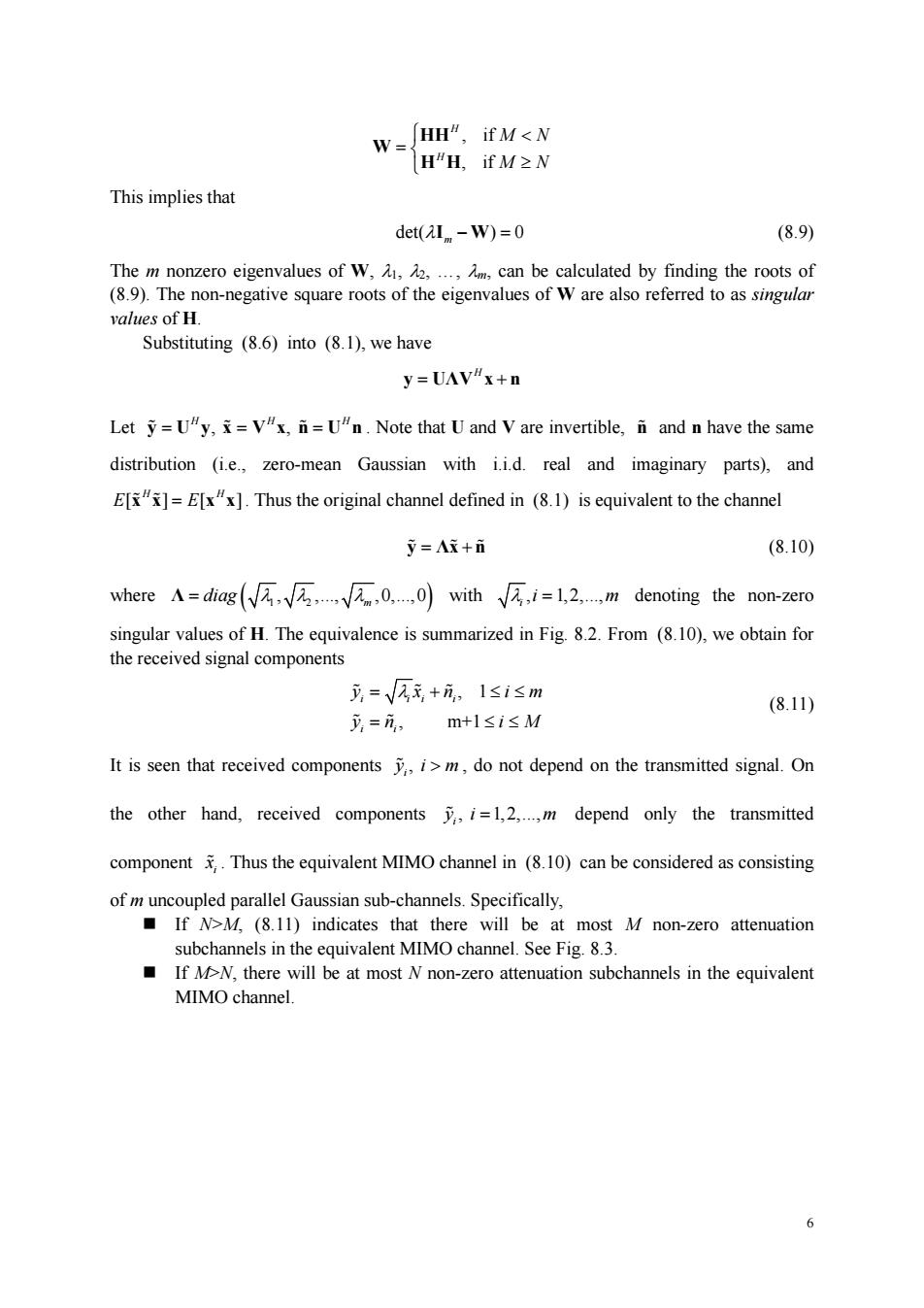正在加载图片...

w=H”,ifM<N HH,ifM≥N This implies that det(I -W)=0 (8.9) The m nonzero eigenvalues of W. Am, can be calculated by finding the roots of ()The non-egativequre root of the of Ware lso referred to values of H. Substituting (8.6)into (8.1),we have y=UAV"x+n Let y=U"y,=V"x,n=U"n.Note that U and V are invertible,and n have the same distribution (ie.,zero-mean Gaussian with i.i.d.real and imaginary parts),and E[]=E[x"x].Thus the original channel defined in (8.1)is equivalent to the channel y=Ai+i (8.10) where A=diag(V万,V,√,0,0)with√,i=l,2,m denoting the non-zero singular values of H.The equivalence is summarized in Fig.8.2.From (8.10),we obtain for signal 立=V月元+元,1≤i≤m 元=元,m+1sisM (8.11) It is seen that received componentsi>m,do not depend on the transmitted signal.On the other hand,received componentsi=1,2,.m depend only the transmitted component ,Thus the equivalent MIMO channel in (8.10)can be considered as consisting of m uncoupled parallel Gaussian sub-channels.Specifically, If N>M (8.11)indicates that there will be at most M non-zero attenuation subchannels in the equivalent MIMO channel.See Fig.8.3 If N.there will be at most N non-zero attenuation subchannels in the equivalent MIMO channel.6 , if , if H H M N M N HH W H H This implies that det( ) 0 I W m (8.9) The m nonzero eigenvalues of W, 1, 2, ., m, can be calculated by finding the roots of (8.9). The non-negative square roots of the eigenvalues of W are also referred to as singular values of H. Substituting (8.6) into (8.1), we have H y U ΛVx n Let , , HHH y U y x Vxn Un . Note that U and V are invertible, n and n have the same distribution (i.e., zero-mean Gaussian with i.i.d. real and imaginary parts), and [][] H H E E xx xx . Thus the original channel defined in (8.1) is equivalent to the channel y Λx n (8.10) where 1 2 , ,., ,0,.,0 m Λ diag with , 1,2,., i i m denoting the non-zero singular values of H. The equivalence is summarized in Fig. 8.2. From (8.10), we obtain for the received signal components , 1 , m+1 i ii i i i y x n im y n iM (8.11) It is seen that received components , i y i m , do not depend on the transmitted signal. On the other hand, received components , 1,2,., i y i m depend only the transmitted component i x . Thus the equivalent MIMO channel in (8.10) can be considered as consisting of m uncoupled parallel Gaussian sub-channels. Specifically, If N>M, (8.11) indicates that there will be at most M non-zero attenuation subchannels in the equivalent MIMO channel. See Fig. 8.3. If M>N, there will be at most N non-zero attenuation subchannels in the equivalent MIMO channel